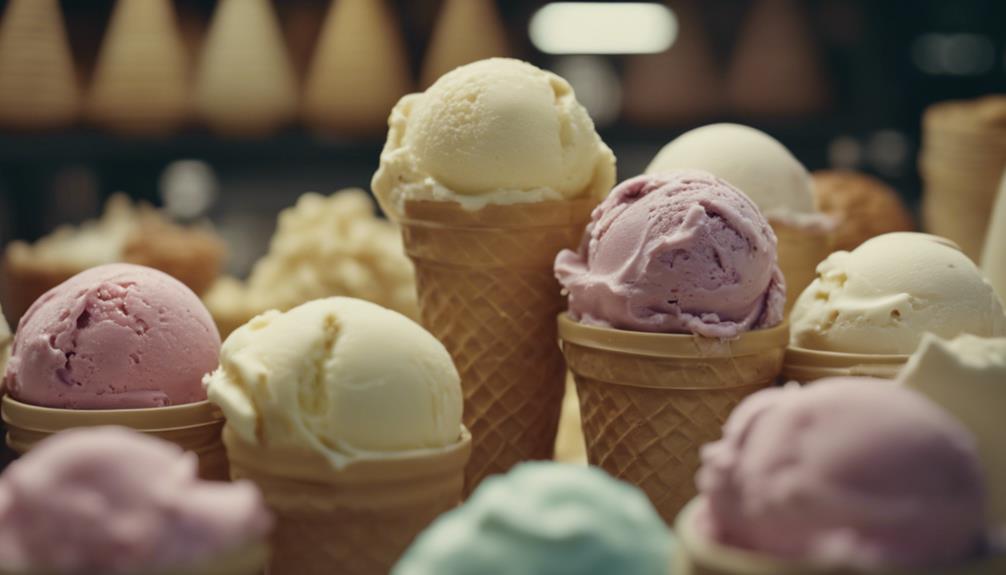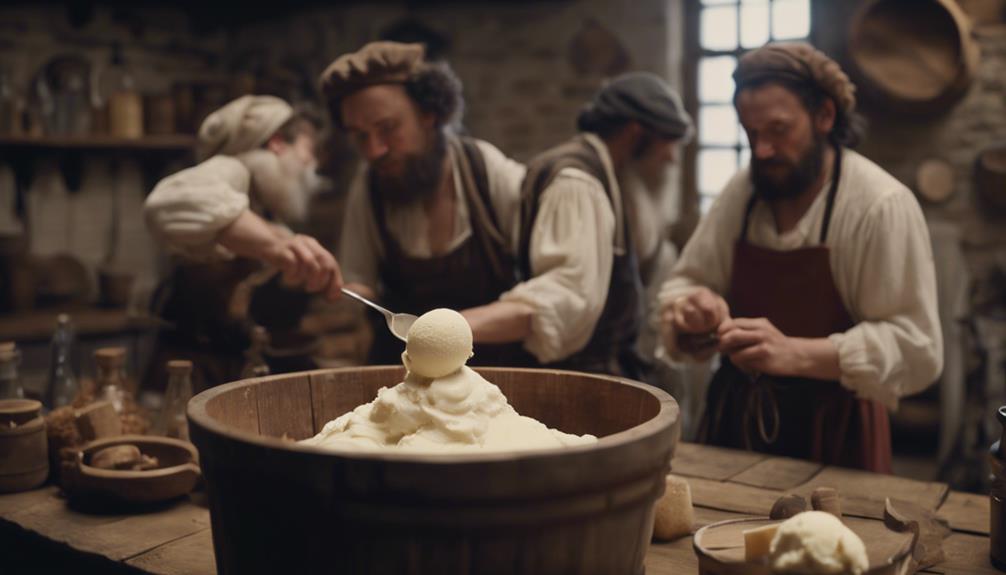Journey back to 500 B.C. Persia to explore the origins of ice cream. Originally known as bastani, this delightful dessert has a fascinating history. Marco Polo introduced ice cream recipes from China to Italy, sharing its deliciousness across different continents. Discover the development of gelato with its decadent texture and special flavors. From Roman emperors to ice cream shops in Paris, the legacy of ice cream is marked by continuous innovation. Delve into how international influences have influenced this cherished treat. The exploration of ice cream’s past guarantees an enjoyable adventure with plenty of unexpected twists.
Key Takeaways
- Ice cream originated in Persia as bastani around 500 B.C.
- Marco Polo introduced ice cream recipes from China to Italy.
- Ice cream spread to Ancient Greece and Rome through cultural exchanges.
- Catherine de Medici popularized frozen desserts, like ice cream, in France.
- Ice cream's global acclaim showcases its enduring appeal across cultures.
Persian Origins and Spread
Ice cream, with its Persian origins dating back to around 500 B.C., has a rich history of spreading across various cultures and regions. In the Persian empire, ice cream, known as bastani, was initially a luxurious treat blending ice with grape and fruit juice.
The evolution of this frozen dessert began when Marco Polo brought ice cream recipes from China to Italy in the 13th century, catalyzing its transformation into a beloved delicacy.
The influence of ice cream extended beyond its Persian roots, reaching Ancient Greece and Rome, where notable figures like Alexander the Great and Emperor Nero savored this chilly delight.
As ice cream continued its journey, Catherine de Medici's introduction of frozen desserts to France greatly contributed to its cultural impact and widespread popularity.
From its humble beginnings in the Persian empire to its global acclaim, ice cream's history is a tribute to its enduring appeal and ability to transcend borders and cultures.
Chinese Influence and Silk Road

Chinese culinary traditions, intertwined with the Silk Road's historical significance, played a pivotal role in shaping the evolution of frozen desserts. Chinese aristocrats delighted in frozen treats made with snow and ice, showcasing an early appreciation for cooling delicacies.
When Marco Polo journeyed from China to Italy in the 13th century, he brought back ice cream recipes, introducing Europe to this delectable dessert. The Silk Road, known for its role in cultural exchange, facilitated the spread of these recipes and techniques, contributing to the development of ice cream across the continent.
Through this exchange, Chinese influence left a lasting mark on the evolution of ice cream, transforming it from a simple mixture of rice and milk in 200 BC China to the beloved frozen treat enjoyed worldwide today.
- Chinese aristocrats savored frozen treats made with snow and ice.
- Marco Polo transported ice cream recipes from China to Italy.
- The Silk Road enabled the dissemination of ice cream recipes to Europe.
- Chinese influence significantly impacted the evolution of ice cream.
- Frozen desserts evolved from rice and milk concoctions to the decadent treats we enjoy today.
Evolution of Gelato and Ice Cream

Gelato, originating in Italy, represents a delightful variation of traditional ice cream with a distinct texture and flavor profile. Originating in Florence, gelato stands out for its lower fat content achieved by using more milk than cream.
The process of making gelato involves churning it at a slower pace than ice cream, resulting in a denser texture that feels creamier on the palate. Unlike ice cream, gelato is served slightly warmer, enhancing its luscious creaminess and flavor. This warmer serving temperature allows the gelato to showcase its rich taste and smooth consistency.
Additionally, gelato contains less air than ice cream, making it denser and more intense in flavor, providing a more satisfying and indulgent experience with every spoonful. The evolution of gelato from traditional ice cream has brought about a delectable frozen dessert that continues to captivate taste buds worldwide with its unique characteristics and irresistible allure.
Ice Cream Innovations in History

Explore the fascinating timeline of historical innovations that have shaped the evolution and popularity of frozen desserts, particularly ice cream.
- Sicilian Man's Sweet Creation: A Sicilian man named Procopio Coltelli is credited with opening one of the first ice cream parlors in Paris in the late 17th century, helping to establish the ice cream industry.
- Emperor Nero's Chilly Indulgence: Emperor Nero of Rome is said to have enjoyed a primitive form of ice cream made by mixing snow with fruits and juices, showing an early version of frozen treats.
- Mechanical Refrigeration Revolution: The invention of mechanical refrigeration in the 19th century played an essential role in the mass production and distribution of ice cream, paving the way for the modern ice cream we enjoy today.
- First Ice Cream Cones: The first ice cream cones were introduced at the 1904 World's Fair in St. Louis, revolutionizing the way people consumed ice cream and adding to its popularity.
- Evolution of Ice Cream: Throughout history, various cultures and innovations have contributed to the development of ice cream, leading to its widespread popularity and diverse range of flavors in the modern era.
Global Impact and Modernization

With its global impact and modernization, ice cream has become a universally beloved dessert enjoyed across cultures and continents. The technological advancements of the 19th and 20th centuries played a pivotal role in revolutionizing ice cream production, leading to its mass availability and the creation of diverse variations. This evolution highlights the democratization of ice cream, transforming it from a luxury reserved for the elite to a treat enjoyed by people from all walks of life.
Moreover, the modernization of ice cream saw the invention of the iconic ice cream cone and the introduction of soft-serve ice cream, further solidifying its status as a beloved dessert worldwide. Ice cream's cultural significance transcends borders, with its global impact reflecting human creativity and shared love for this frozen delight.
The countless flavors and innovations that continue to emerge showcase how ice cream remains a tribute to the ingenuity and passion of people around the world.
Frequently Asked Questions
Who Actually Invented Ice Cream?
You may be curious about who invented ice cream, but its true origin remains a mystery. Ancient civilizations like the Greecians, Romans, and Tang dynasty in China all played a role in its development. According to historical records, the Emperor Nero of Rome is said to have sent slaves to the mountains to fetch snow, which he then flavored with fruits and juices. The Greecians also enjoyed a similar dessert made from snow and honey. The invention of the ice cream cone in the early 20th century revolutionized the ice cream melting process, allowing for a more convenient and portable way to enjoy the frozen treat. In the 16th century, the Chinese were known to mix milk and rice to create a frozen dessert. It wasn’t until the 17th century that Italian chefs began experimenting with new flavors and refining the ice cream recipe. Today, ice cream comes in a variety of flavors, but there’s no denying the joy that comes with indulging in a scoop of chocolate ice cream happiness.
Who First Thought of Ice Cream?
When pondering who first thought of ice cream, imagine the delight that sparked the creation. As civilizations mixed and mingled, the idea of a frozen treat evolved, leaving us today with the delicious result.
Who Created the First Frozen Dessert?
You wonder who created the first frozen dessert. Many ancient civilizations like Persians, Chinese, and Italians contributed to its evolution. Despite its elusive origins, ice cream's journey showcases centuries of creativity and cultural exchange.
Did Martha Washington Invent Ice Cream?
No, Martha Washington did not invent ice cream. However, she is believed to have helped popularize it in America. Her recipes included a creamy frozen dessert similar to ice cream, showcasing her influence on early American cuisine.
Conclusion
So, now you know the sweet history of ice cream from its Persian origins to modern innovations.
As the saying goes, 'All good things take time,' and ice cream is no exception.
From humble beginnings to global popularity, this frozen treat has evolved and delighted taste buds for centuries.
Enjoy a scoop of history next time you indulge in a cone of this delicious dessert!








